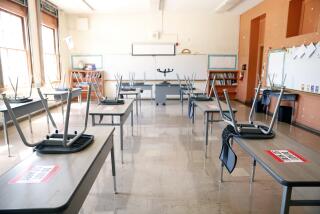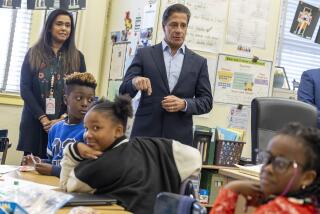The Riddle of ‘Noninstructional Instruction’
- Share via
The bell rings at Dorsey High School and students spill out of their classrooms. A girl sips a Coke at her locker. Two sweethearts embrace. Others mingle on the grassy quad.
A little relaxation between classes, right?
Wrong.
These students are technically in class, thanks to a bureaucratic edict that treats “passing periods” as an instructional activity in California’s schools.
In the oxymoronic jargon of education, these several minutes between classes are called “noninstructional instructional time.”
A few minutes here or there might not seem like much to moan about. But schools are paid for those minutes--they are part of the minimum time students must be enrolled for campuses to get state funding. And more important, those minutes add up to a month or more of class time over the course of a school year.
That’s one full month of class time lost to students who need every minute to prepare for tests from the SATs to the state’s high school exit exam that takes hold in 2004.
Dorsey Principal Evelyn Mahmud calls passing periods “bathroom time, not instruction time.”
Dorsey senior Andrew Anderson sees little educational value in scrambling across campus between classes.
“If there’s anything I learn, it’s not to get caught in a tardy sweep,” Anderson said.
Although there is some concern that counting passing periods as class time may conflict with state law, the practice has been an open secret for years among educators.
To some, it’s something to be winked at. To others, it’s a sham akin to rules proposed in the early 1980s by the Reagan administration to list ketchup as a vegetable in school lunches.
“An attorney wouldn’t bill those hours,” said Ilene Straus, the principal of Lincoln Middle School in Santa Monica.
Of course, some see worth in passing periods, which last as long as 10 minutes and apply only to middle schools and high schools, where students move from classroom to classroom throughout the day.
Students can approach a teacher after class to ask a question, clarify an assignment or scribble a little extra credit. Teachers and students alike use the time to regenerate and switch gears.
“I think the down time is just as important as class time,” said Jeffe Huls, a choral music teacher at Lincoln. “You need that wind-down time.”
The origin of the practice is murky.
State staffers are not sure how long schools have been counting passing periods as instructional time. But by 1953, the state Department of Education mentioned the practice in an official manual, apparently giving its approval of passing periods as a routine and necessary part of the school day. There is only one problem with this reasoning: Counting passing periods as class time apparently conflicts with state law.
The state Education Code says students are officially in school when they are engaged in educational activities under the “immediate supervision and control” of a teacher or another employee with a valid credential.
Said Chuck Pillsbury, an official with the state Department of Finance: “There is no legal authority to claim this time, “
But Delaine Eastin, the state’s superintendent of public instruction, said the focus of schools should be on the quality, not the quantity, of class time.
“Why aren’t we putting more attention into whether kids are learning instead of accounting for every minute of every hour of every day?” Eastin asked. “We shouldn’t be spending all of our time on this parsimonious nonsense.”
Parents aren’t concerned about arcane legal arguments. They object to losing valuable class time.
“I don’t like it,” groused Judi Appleman, whose daughter, Sarah, is a junior at Northwood High in Irvine.
Appleman complained that her daughter’s class time is already eaten up by endless testing, parent conferences and other disruptions. Sarah is spending a good chunk of the spring taking a bevy of high-powered tests, including the Stanford 9, two Advanced Placement exams and the SAT. Appleman asks a reasonable question: Why not lengthen the school day to make up for the time spent passing between classes?
That is not a popular idea with teachers or the unions that represent them.
The teachers question whether a longer day will mean more learning. Instructors and students alike, they say, burn out toward the end of the day. And some don’t want to work more unless they get paid for their time, a sensitive issue that could pit unions against school districts.
“There’s a law of diminishing returns,” said Wayne Johnson, president of the California Teachers Assn. “In the long run, I think it would be counterproductive. We have enough instructional minutes. I think we need to do more with what we have.”
That very theme is echoed by Straus, the principal at Lincoln Middle School. She says passing periods aren’t the issue--it’s how instructors use their time overall.
At Lincoln, a campus that has earned accolades from state and national educators, English and history classes are offered in “blocks” of two periods that give teachers more flexibility in how they use classroom time. Students then get more concentrated instruction. And the school makes sure everyone stays on track so they don’t fall behind. Anyone who fails to do homework, for example, must stay after school to finish it.
“We have enough time if we use it right,” Straus said. “We work our students’ tails off. We really work them hard.”
More to Read
Sign up for Essential California
The most important California stories and recommendations in your inbox every morning.
You may occasionally receive promotional content from the Los Angeles Times.













